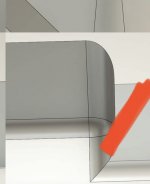I know little about CNC and have been learning the basics over the past month.
I'm working on a chassis weight for the Tremor 50 using their custom rail system. Made two 3d prints to check clearance and fit. Now I'm ready to get a pair cut in 360 brass to see how well they hold up. Testing jerry rigged weights I find 9lb total added on is much more comfortable. One of these is 4.6~ lb, two can be mounted.
Xometry.com is easy to get setup on so that's what I've been using. They are quoting $265 each made internationally (probably China) and double for that USA with 0.1mm tolerance in about 20 locations, 3.2um finish. Part is 300mm x 55mm x 17.75mm. That seems like the best deal I am going to find along with fairly quick turn around of 2 weeks, but if anyone has other places to check that would be great.
From what can be seen below, are there any obvious rule of thumb violations for CNC design? The filet corners are setup for a 4mm ball end mill.



I'm working on a chassis weight for the Tremor 50 using their custom rail system. Made two 3d prints to check clearance and fit. Now I'm ready to get a pair cut in 360 brass to see how well they hold up. Testing jerry rigged weights I find 9lb total added on is much more comfortable. One of these is 4.6~ lb, two can be mounted.
Xometry.com is easy to get setup on so that's what I've been using. They are quoting $265 each made internationally (probably China) and double for that USA with 0.1mm tolerance in about 20 locations, 3.2um finish. Part is 300mm x 55mm x 17.75mm. That seems like the best deal I am going to find along with fairly quick turn around of 2 weeks, but if anyone has other places to check that would be great.
From what can be seen below, are there any obvious rule of thumb violations for CNC design? The filet corners are setup for a 4mm ball end mill.



